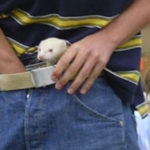 Technology
Technology  Technology
Technology  Humans
Humans 10 Everyday Human Behaviors That Are Actually Survival Instincts
 Animals
Animals 10 Animals That Humiliated and Harmed Historical Leaders
 History
History 10 Most Influential Protests in Modern History
 Creepy
Creepy 10 More Representations of Death from Myth, Legend, and Folktale
 Technology
Technology 10 Scientific Breakthroughs of 2025 That’ll Change Everything
 Our World
Our World 10 Ways Icelandic Culture Makes Other Countries Look Boring
 Misconceptions
Misconceptions 10 Common Misconceptions About the Victorian Era
 Mysteries
Mysteries 10 Strange Unexplained Mysteries of 2025
 Miscellaneous
Miscellaneous 10 of History’s Most Bell-Ringing Finishing Moves
 Technology
Technology Top 10 Everyday Tech Buzzwords That Hide a Darker Past
 Humans
Humans 10 Everyday Human Behaviors That Are Actually Survival Instincts
 Animals
Animals 10 Animals That Humiliated and Harmed Historical Leaders
Who's Behind Listverse?

Jamie Frater
Head Editor
Jamie founded Listverse due to an insatiable desire to share fascinating, obscure, and bizarre facts. He has been a guest speaker on numerous national radio and television stations and is a five time published author.
More About Us History
History 10 Most Influential Protests in Modern History
 Creepy
Creepy 10 More Representations of Death from Myth, Legend, and Folktale
 Technology
Technology 10 Scientific Breakthroughs of 2025 That’ll Change Everything
 Our World
Our World 10 Ways Icelandic Culture Makes Other Countries Look Boring
 Misconceptions
Misconceptions 10 Common Misconceptions About the Victorian Era
 Mysteries
Mysteries 10 Strange Unexplained Mysteries of 2025
 Miscellaneous
Miscellaneous 10 of History’s Most Bell-Ringing Finishing Moves
Top 10 Arthropod Pets
Arthropods have external skeletons, segmented bodies, and several jointed appendages. There are many different kinds of arthropods, including arachnids, insects, and crustaceans. Where some people regard these creatures as pests, others enjoy them as pets. The collection and keeping of these fascinating creatures is a growing hobby amongst many people. There are many sources for purchase, and quite a few forums dedicated to this most interesting field. Please be aware that not all of these are legal to own, and should not be released into the wild if they are not native to your area. The following lists ten common arthropod pets, in no particular order.
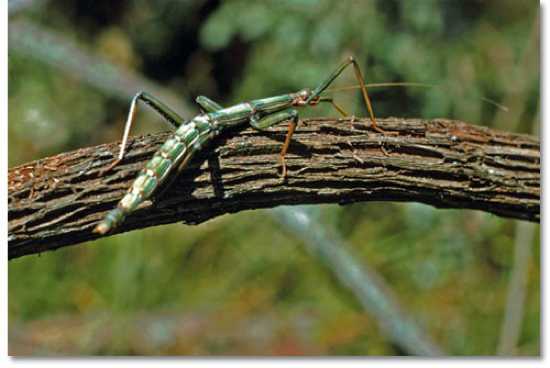
The walking stick, otherwise known as stick insect, stick bug, phasmids, ghost insects, or leaf insects, is an herbivore, living on leaves and other plant material. There are over 2,500 species. They are longer and thinner than the mantis, and are often confused as mantids. Although they fall under the subclass pterygoda, meaning winged insect, they have no wings. They go through three life stages: the female drops many eggs that land wherever in the autumn, nymphs emerge in the spring, and by summer they are adults. The female can reproduce without males, and the offspring will be clones of the female. They survive by camouflaging themselves to look like the twigs and branches they perch on, even mimicking the color of said branch.
As pets, they are easy to care for. Just try to imitate their natural environment with the proper humidity, temperature, and food. Handling is easy, as they are not aggressive, but are delicate and should be handled gently. The Indian walking stick is a popular classroom pet. They can be left alone for up to a week with no adverse affects.
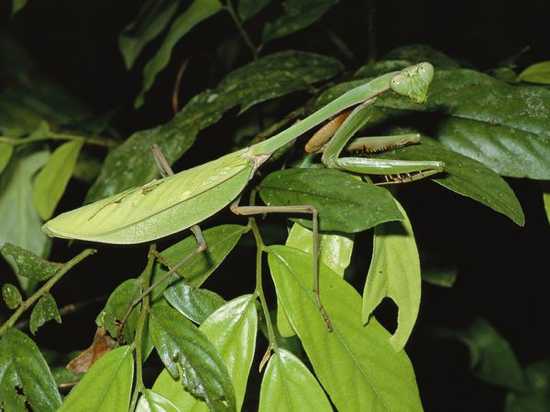
The praying mantis is so called because of its long spiked forelegs that are bent as if in prayer. Using these legs, the mantis lunges, grabs its prey, and holds it while eating it alive. They are predators, living on other insects, even cannibalizing one another at times. They lay their eggs in the autumn in layered clusters, covered by a foam that hardens and is waterproof, hanging from a branch. In the spring, the tiny babies that survived by not being eaten by their siblings or other insects climb the branch and go through several metamorphosis until they are adults. With their final metamorphosis, they have wings.
As pets, they are fun to watch. Feeding is generally easy, as they are aggressive and quick to snatch the offered food. Watching them eat may take a strong stomach, as the prey is alive and struggling through most of the ordeal. There are many different kinds of mantises in the pet trade, at all sorts of sizes. The largest mantis is the ischnomantis gigas, at a whopping 6 1/2 inches. The smallest is the bolbe pyhmaea, at about less than half an inch. It is well known that the female will eat the male during copulation. However, this does not always happen, especially if the female has been well fed prior.
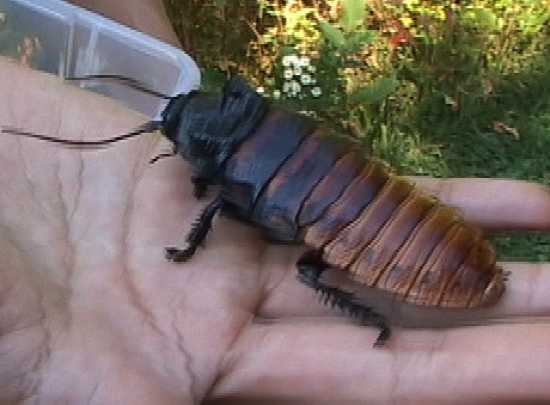
Most people think of roaches as pests. Yet only 5 or so out of 4,000 species of roaches are household pests. Roaches adapt easily to their surroundings, although they are typically found in warm areas. They are mostly omnivores, but there are some species that eat wood. They are fast and very hardy, and can survive without food for a long time, without air for up to forty five minutes, and being submerged in water for half an hour. It is believed that roaches would survive a nuclear holocaust, and they certainly have a higher resistance to radiation than humans. As pests, they can leave trails of bacteria with their feces and cause allergic reactions in humans.
But as pets, they are colorful, entertaining, and easy to care for. There are many beautiful specimens to choose from in the pet trade. The hissing cockroach is probably the most well known. Blaberus Craniifer, the true death head roach, is a lovely specimen that has the death head image on the back of its head. Feeding is simple, grind up some dry dog food and grain, or buy commercial roach jelly online. Misting is helpful, as some like to lick the drops off the side of the aquarium. Some are good climbers, and an inch of vaseline around the top of the aquarium will keep them inside. They can be held easily, although you should wash your hands after. Breeding is easy, just keep a male and female together, and soon you will have lots of babies. The dubya roach is often used as a food source for other pet insects.
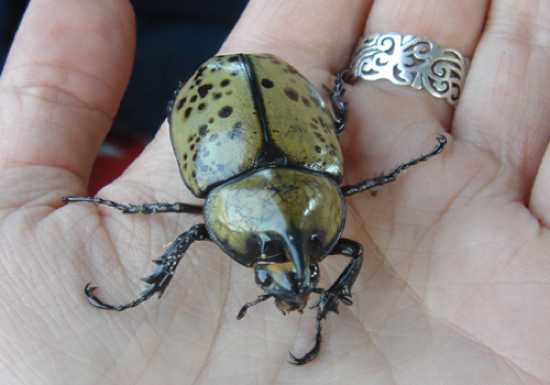
There are more than 350,000 species of beetles in the world, living in diverse places like deserts, tropical climates, and even in water. Some are pests that eat garden plants and some eat the pests, like aphids and mites, that eat garden plants. Some are useful in cleaning up carrion or dung. And some are eaten by other insects, animals, and birds. They lay eggs that hatch into larvae that can in some cases take years to become mature adults. The adults are generally not long-lived.
In Japan, the rhinoceros beetle is a popular pet. They have a horn on the thorax and a horn pointing forward from the center thorax. They can reach almost 6 inches long and weigh 3 ounces. They can be purchased from stores and even vending machines. Sometimes they are used for gambling, fighting one another, as males tend to be combative. The Goliath beetle is one of the largest and heaviest at up to 2 to 3 inches long and weighing a hefty 3 or 4 ounces. It belongs to the scarab family. The scarab family has some of the most beautiful markings and colors. Beetles are a little harder to find in the pet trade, and you may have to start with a larvae that will remain buried most of the time. But if you are patient, you will briefly have a fascinating pet.

Ants are everywhere. They are predators, scavenger, and herbivores. They are very social and live in groups with a hierarchy. The colony is ruled by a queen, who is the only fertile female. The other, infertile females, are workers and soldiers. They communicate through pheromones, sounds, and touch and defend themselves by biting or stinging. They are related to wasps and bees. Some, like harvester ants are sold as food for pet horned lizards.
Harvester ants are also sold for ant farms, a fun hobby many children and adults enjoy. Harvester ants have large jaws and will bite. These farms are flat so the ants can be viewed as they go about their daily lives, building tunnels and carrying food. They should be fed a healthy diet of fruit, vegetables, birdseed or the white of a boiled egg. Special ant food can be ordered online. An eyedropper works well to deliver just a little bit of water to one area, not so much that any of the ants will drown. It is fun and educational to watch the socialization and teamwork of these enterprising creatures. It would be even more entertaining to watch them breed and raise babies, but queens are not usually offered as pets. For that, you may have to catch one.
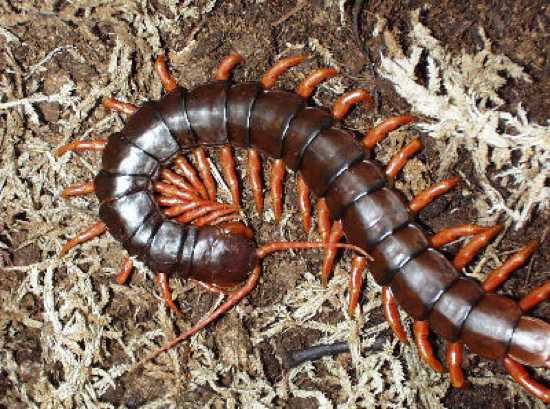
Centipedes are fast and aggressive. They can be found in the tropics and in deserts. They hunt at night and eat roaches, crickets, mice and bats. If bothered, they will bite or pinch, and are venomous. They have flattened bodies, a single pair of legs per segment, and can get up to twelve inches long. There are over 8,000 species.
These are pets for the advanced keeper. Care must be given that they do not escape. They are cannibalistic and must be housed separately. Some can live more than a decade in the wild, and even longer as pets. Even though they can live in the desert, they require dark, damp habitats with plenty of hiding places. They molt seven to ten times before maturity. Centipedes do not have 100 legs like their name implies; rather they always have an odd number of legs. Usually the female of the species will grow larger than the male or have different colors. And while some people will hold their pet centipede, it is advisable not to.
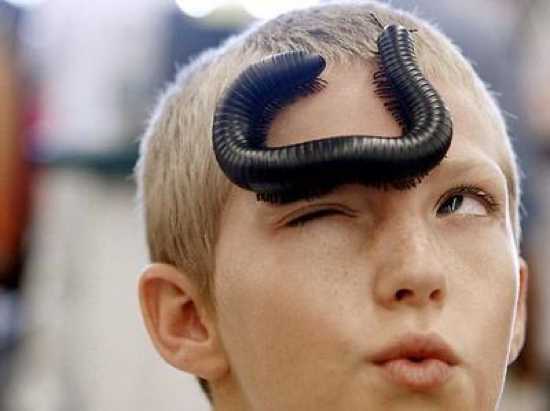
Unlike centipedes, millipedes are long, round, slow, and eat decaying vegetation. They also have 2 pair of legs per segment, as opposed to 1. They can have 36 to 400 legs, depending on the species. There are over 10,000 species. Millipedes burrow into the ground. Some may secrete a poison through their skin, and there are some mammals that get drugged off this secretion by licking the millipede. They defend themselves by curling into a ball and do not bite.
Millipedes are easy to house and can live in groups. The giant African millipede is a popular pet, getting as big as 10 inches. They can be long lived and are non aggressive, making them fun to hold. Pet millipedes will eat fruit or vegetables, and need extra calcium to aid in shedding. They like damp areas and live under plant debris, and need a somewhat deep substrate so they can burrow. Being nocturnal, they aren’t quite as visible as some pets, so you would want to watch them at night. They reproduce easily, so take care not to house males and females together if you don’t want a lot. While they are not aggressive, some people may have allergic reactions to their secretions and should take care.
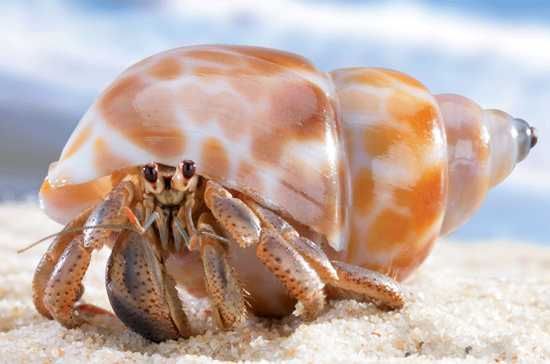
Hermit crabs live in shells and as they grow change to newer, larger shells. The largest species can live 30 to 70 years or more. They are great climbers and diggers, and fun to watch. Some species live under water, like marine crabs, and others on land. Most are aquatic, living in saltwater, and even the land ones must return to the sea to breed. There are many different colors, like red, brown, and purple, with varying patterns such as dots and stripes. They are scavengers and omnivores, eating dead things and plants.
They are a popular pet, but many people do not realize how much care must be given to them. As a result, they are short lived as pets. They need space, proper substrate, fresh water, salt water, food, extra shells, and things to climb. For specifics, please go to the site mentioned above. If you want your hermit crab to live and be healthy, you must meet their specific needs.
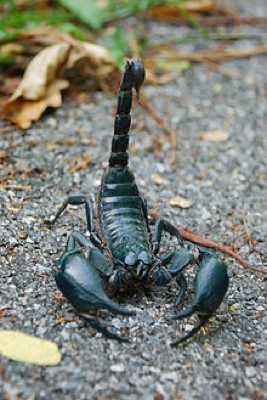
Scorpions are predators, eating other insects. They sting their prey to paralyze it before eating. There are over 2,000 species, and 30 or more have the venom that can kill a human. They grow from between 0.3 inches to 9 inches long. They have 8 legs, 2 claws that vary in size according to species, and a segmented tail with a stinger on the end.
The emperor scorpion is probably the most common scorpion kept as a pet. They are black and have large claws, and grow to 6 inches. Give them a place to burrow or hide, some crickets or roaches, proper heat and humidity, and a shallow water bowl. They can live 6 to 8 years, and shouldn’t be handled, although their venom isn’t as potent as other species. More than 1 can be kept together, as long as there are enough hiding spots and room to move. Since they are nocturnal, they will be more interesting to observe at night.
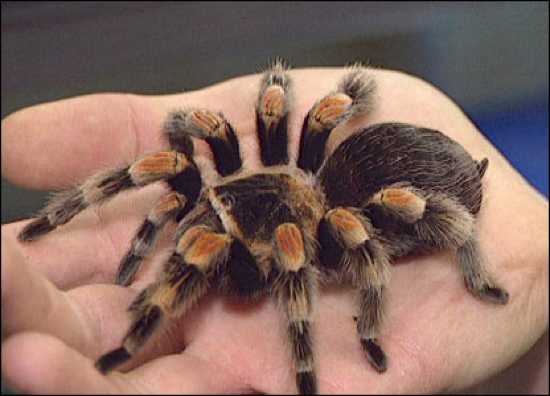
This particular arthropod is my favorite. There are so many different sizes and color combinations and temperaments to choose from. Some have stripes like a tiger, and some have markings like a skeleton. Most are hairy. They can be found in America, Africa, Asia and Australia. The African and Asian tarantulas are known as old world, and typically have stronger venom and are more aggressive than the new world tarantulas found in America that usually will just flick irritating hairs when threatened. They eat quite a variety of living things, from crickets to mice. Some are arboreal, living high up in trees and others are terrestrial, living on the ground or in burrows.
They are easy to find in the pet trade. They range in size from a fingernail to a dinner plate. In an appropriate size enclosure, the burrowing species will dig and line a hole with webbing. Mine do this right up against the glass so I can always see them even when they are hiding. Feeding is entertaining. Drop the cricket or roach in and watch the tarantula dash out and grab it. The largest ones can be fed mice or rats, but it is unadvisable because the rodent might hurt the tarantula. Large dubya roaches work well for large tarantulas. Some tarantulas go long periods of time without eating, either because they simply aren’t hungry, or are getting ready to molt. That is also interesting, to peer into the enclosure and see what looks like 2 tarantulas! Because when they molt, they lay on their backs and step out of their old skin, leaving behind what looks like another whole tarantula. Don’t feed for a few days after molting as the tarantula is vulnerable and the fangs need to harden.





